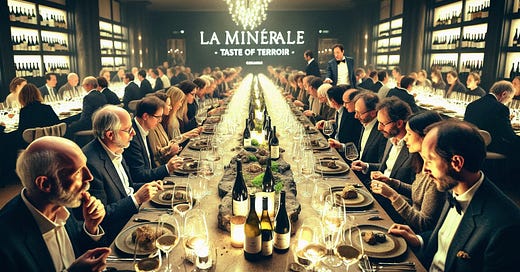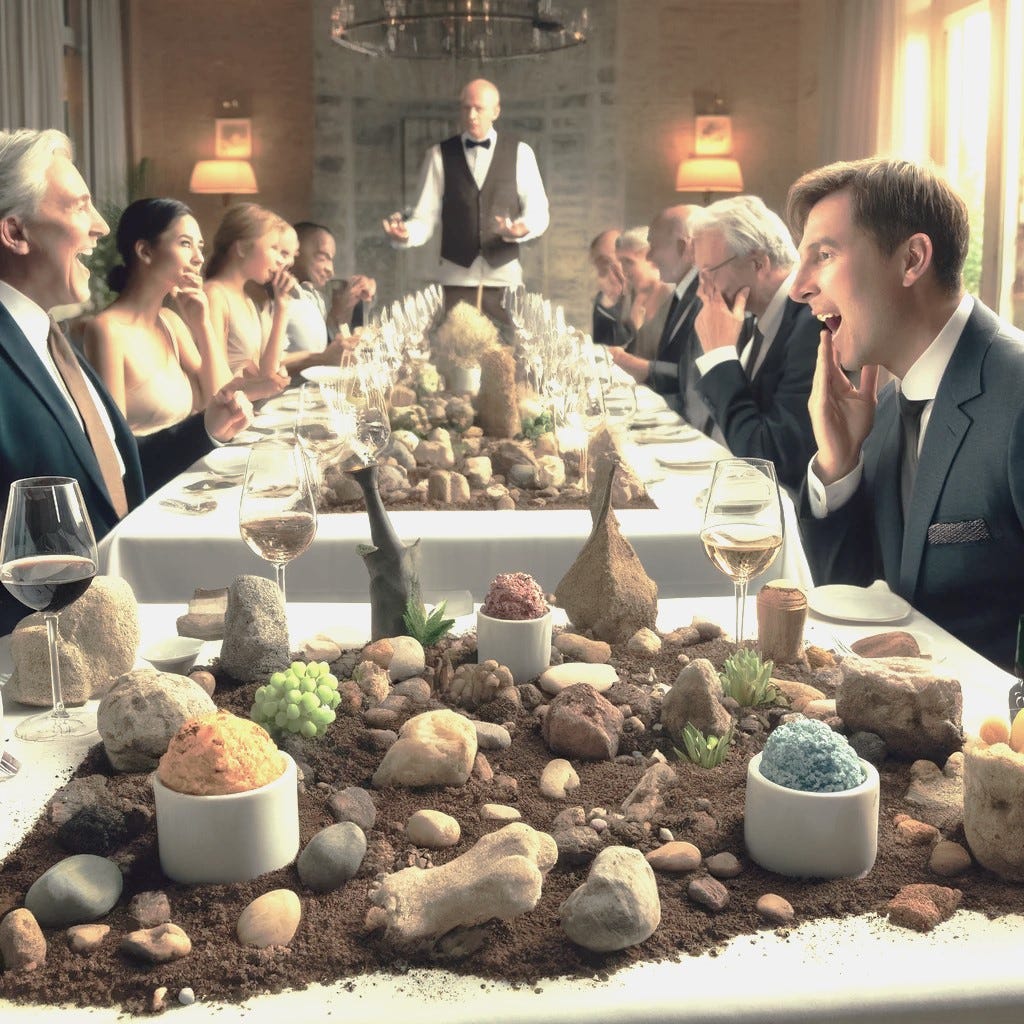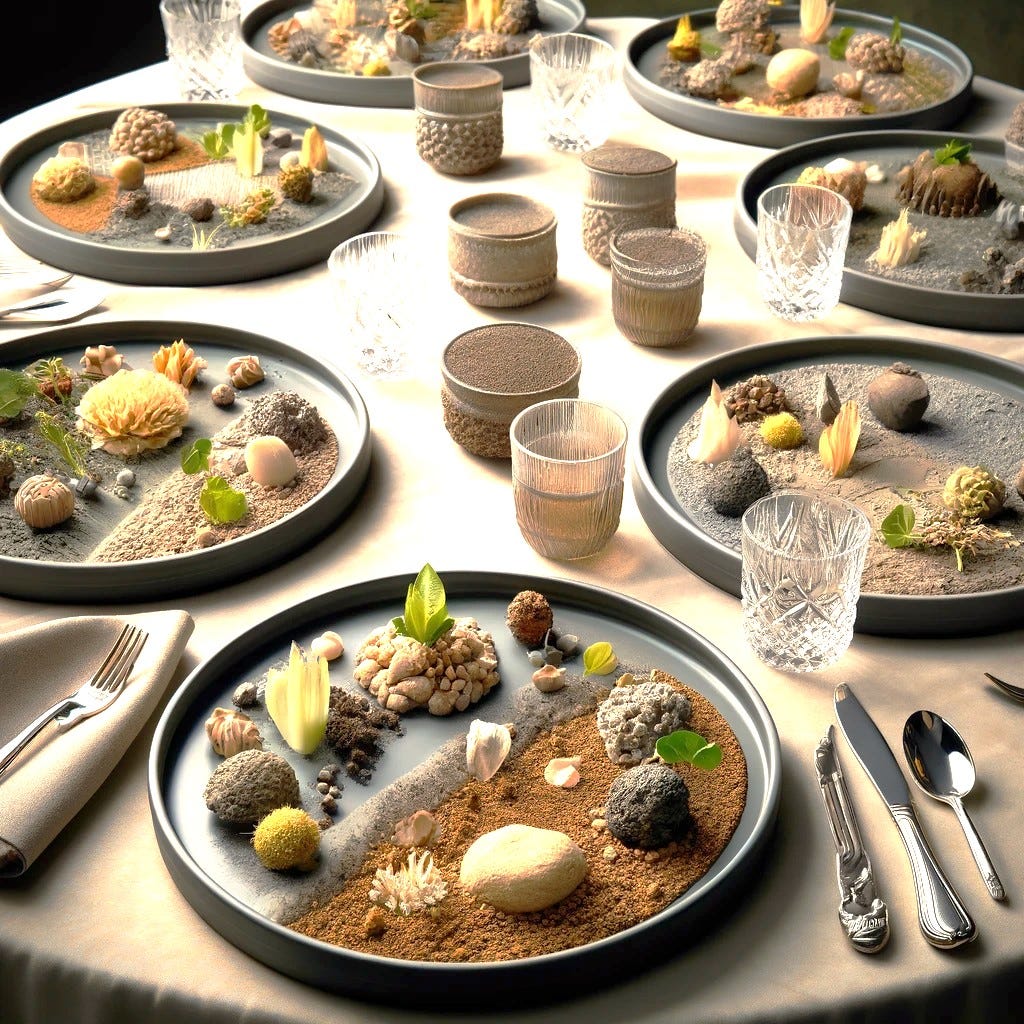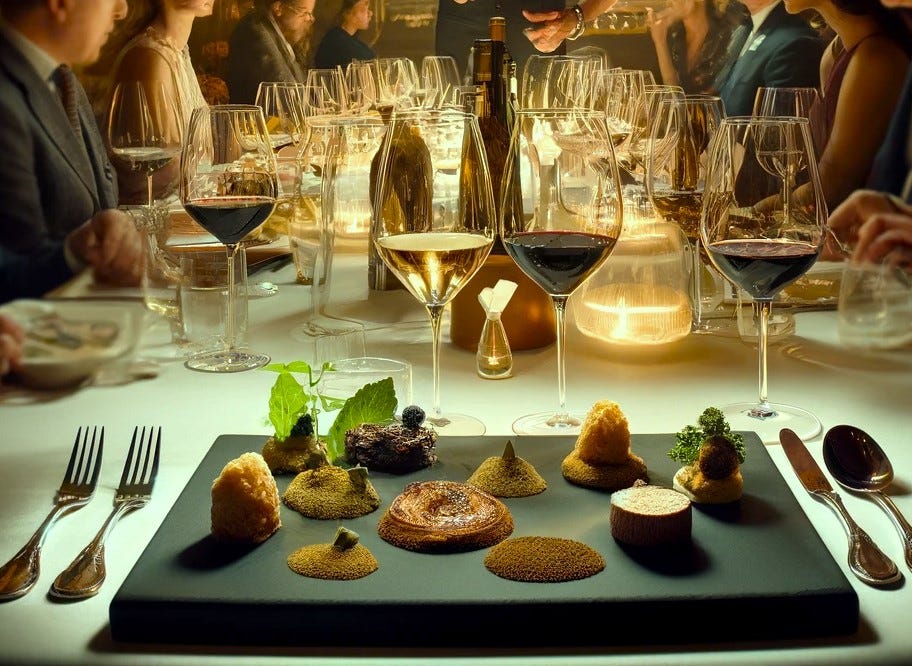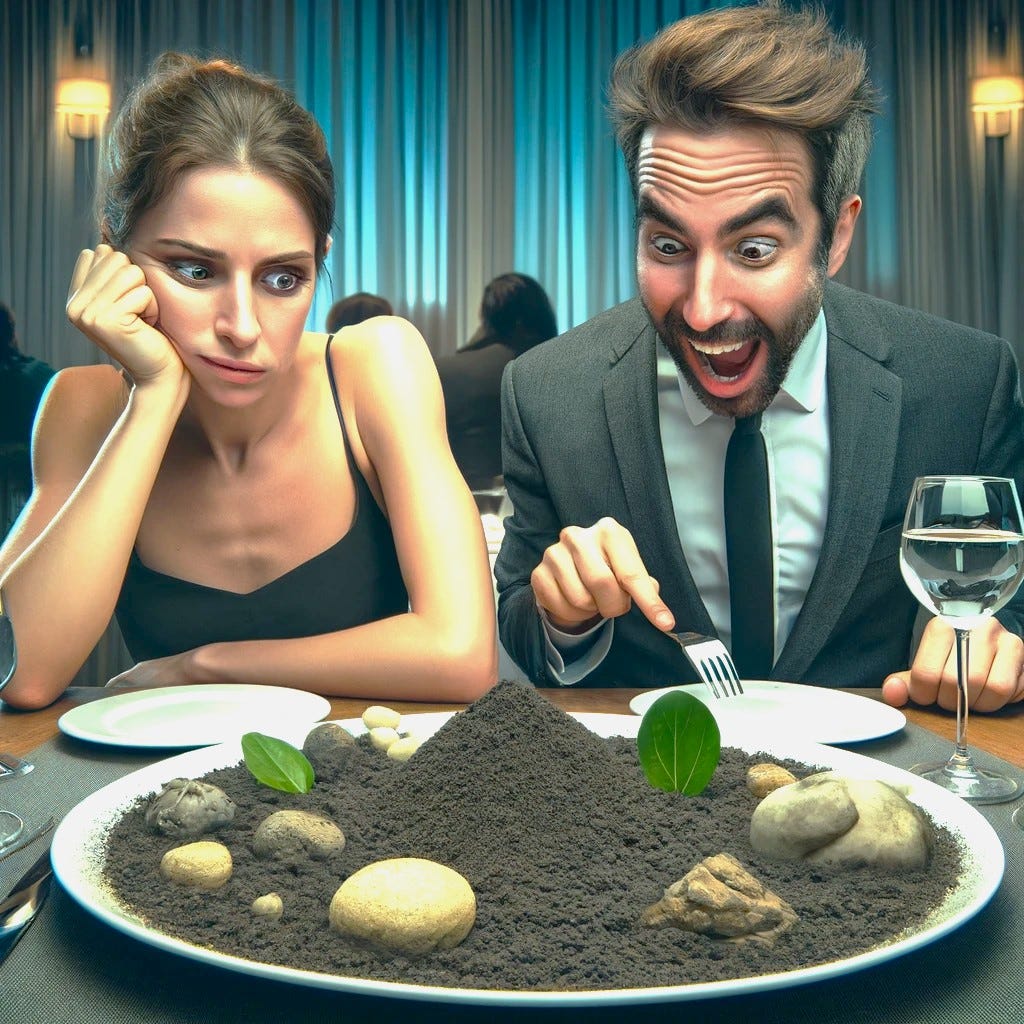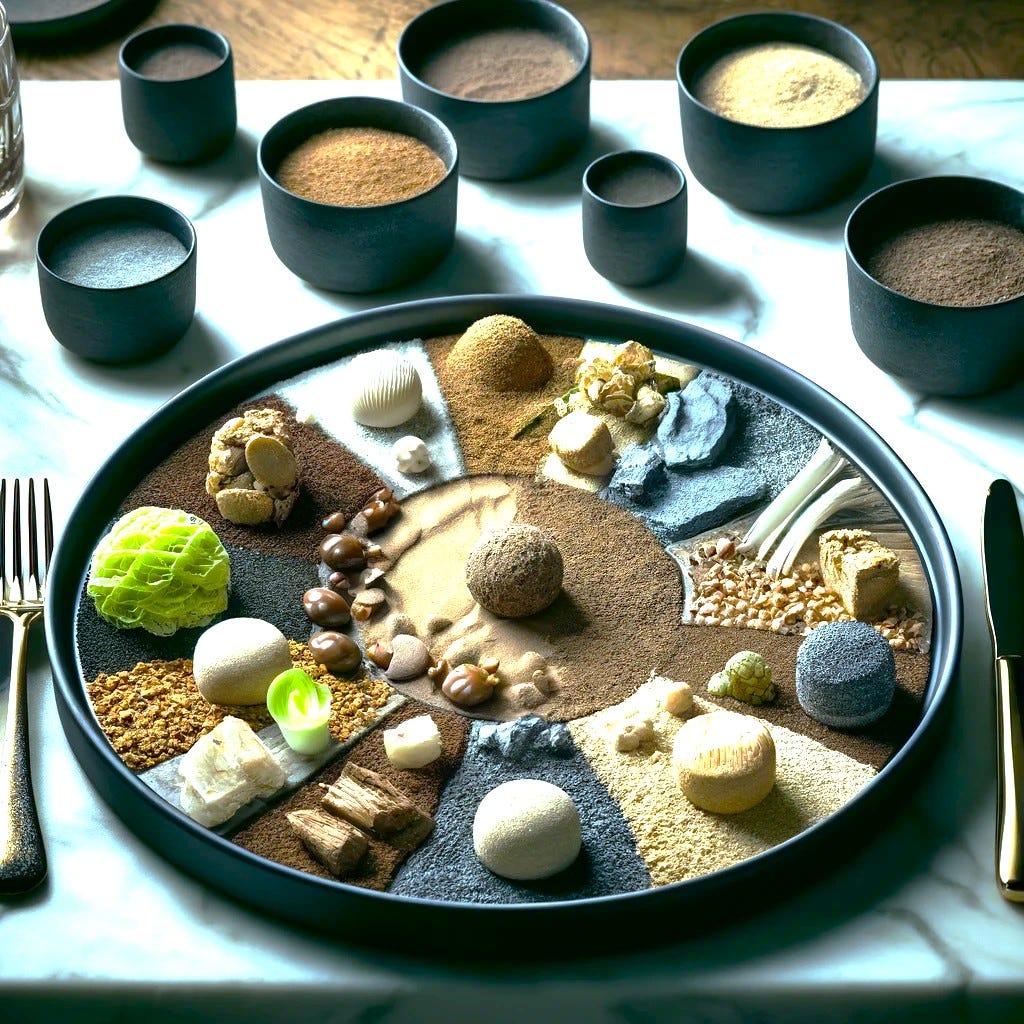When an invitation lands in the Indelible Wine Stain inbox for a wine dinner hosted by a famous geologist-turned-sommelier or ‘Geo-Somm,’ curiosity piques like mouse to a Cheeto. When the menu boasts dishes made from literal soil, earth, and rocks, paired with some of the world's finest wines, it’s an offer you can't refuse. So, on a crisp autumn evening, we joined other brave souls for what promised to be a groundbreaking dining experience.
The dinner took place at “La Minerale,” a chic restaurant known for pushing culinary boundaries. That night, it was transformed into a geologist’s paradise, complete with rock formations on each table and Mosesesque menus, tapped out onto thin slate tablets, sourced from the Mosel Valley.
The famous Geo-Somm, Dr. Ernie Gallaston, greeted us all like with the bellow of a Town Cryer, with a hearty "Welcome to the core of gastronomy!"
There he stood before the guests with a confident smile, gesturing towards the array of wine bottles and the meticulously crafted dishes. He began to explain how terroir influences the taste of wine.
“Ladies and gentlemen, tonight we explore the mysterious world of terroir and its profound impact on wine,” he began. “Terroir is not just about the soil; it's the climate, the landscape, the culture, and even the spirit of the land. All these elements work in harmony to create something truly unique.”
Is the magic of terroir truly from the signature of the soil? I wondered.
“Take granite, for instance,” he said, holding up a glass of an excellent Rostaing Côte-Rôtie. “This wine draws its smoky, peppery notes directly from the granite soils of the Northern Rhône. The mineral essence permeates the grapes, giving them that unmistakable granite signature.”
But what of the influence of climate, I heard myself think.
“Consider the limestone," he continued, pouring a Guegen Chablis. "You see, limestone retains heat during the day and cools at night, giving crisp acidity and citrus notes. It’s like tasting a cool breeze over sun-warmed chalk."
The "Molecular Osmosis of Terroir Essence" (MOTE) Theory
Dr. Gallaston, known as “Ernie Rocks” to his friends, firmly believes that soil can release flavor molecules that travel up the vine into the grape. He calls this theory M.O.T.E.
He teaches soils are giant infusers brimming with natural flavor compounds.
He argues that each soil type contains unique “terroir essences” or as he calls them “terressences,” that are specific to the region. For example, granite has peppery notes, limestone yields citrusy flavors & clay soil imparts earthiness.
His theory suggests that as vines absorb water and nutrients from the soil, they also absorb these flavor molecules via a specialized biological process akin to osmosis. Similar to learning about the production of wine by tasting it.
These flavor molecules then travel up through the vine’s vascular system, eventually reaching the grapes.
The “Peach Orchard Proximity Effect”
Citing the example of a vineyard located near a peach orchard, he believes that volatile compounds from the peaches settle into the soil and are then absorbed by the neighboring grapevines leading to peach notes in the wines.
He further expands on the idea with the "Atmospheric Infusion Hypothesis." This posits that aromatic compounds released by nearby flora are carried in the air and subsequently absorbed by the soil. The soil acts like a sponge, storing these fragrances until they are ready to be drawn up by the roots.
Once inside the grape, it acts as a conduit with flavor molecules interacting with the grape’s natural sugars, acids and phenolic compounds.
He believes that this process is responsible for the subtle notes of pepper, citrus, earth, or even peaches that can be detected in the finished wine.
"Terroir is not just something you taste; it's something the vine breathes in. When you sip a wine, you're savoring the spirit of the soil itself."
Back to La Minerale and a Taste of Terroir
"Tonight, we embark on a journey through the soil," he began. "The gastronic experience is about tasting the earth itself, through both the wine and food. Chef Schultz has curated a menu that harmonizes with distinct terroirs of each wine. To truly appreciate the essence of a wine, we must also taste the essence of the earth." With that, the first course was served.
First Course - Limestone and Chablis
Oyster Tartare with Dill Oil, Oyster Foam, Lemon Gel on Limestone Pebbles
with Domaine Guegen, Chablis “Bougros Grand Cru” 2011
Briny, fresh oysters elevated by crisp, citrus minerality of the Chablis, grown on limestone-rich Kimmeridgian soil. While inventive, this had several guests discreetly spitting out bits of sediment. The pairing was exquisite, though the dental damage was not. One guest muttered about needing a dentist.
Second Course - Slate and Riesling
Slow-Cooked Trout with Dill Butter, Pickled Cucumber, Slate Salt
with Dr. H. Thanisch, Berncasteler Doctor, Kabinett 2017
The flinty, mineral-led freshness of the wine cuts through the richness of the trout, while the slate salt brought forth the characteristic terroir of the Mosel. The lightness & acidity resonated perfectly with the wine's vibrant citrus notes.
Third Course - Volcanic Soil and Etna Rosso
Charcoal-Grilled Octopus with Black Garlic Purée, Smoked Eggplant Caviar
with Tenuta delle Terre Nere, Etna Rosso “La Vigna Di Don Peppino” 2014
The volcanic soil of Mount Etna lent its distinctive character to the Etna Rosso, which boasted vibrant acidity and elegant tannins. The octopus, grilled to perfection, with a volcanic soil glaze was complemented by the smokiness of black garlic & eggplant, creating a synergy between wine and volcanic earth.
Fourth Course - Granite and Côte-Rôtie
Crayfish Poached in Granite-Infused Butter, Roasted Fennel and Thyme
with Domaine Rostaing Côte-Rôtie “La Landonne” 1991
Chef extracted the mineral essence of granite by poaching crayfish in granite-infused butter. Subtle earthiness harmonized with the smoky and peppery notes of the Côte-Rôtie. Dr. Gallaston explained how the steep slopes of Côte-Rôtie are composed of granite, imparting the distinct minerality and depth.
Fifth Course - Clay Soil and Pomerol
Duck Breast with Petrus Clay Soil Reduction, Celeriac Purée, Wild Mushrooms
with Château La Conseillante 1996
Rich duck, beautifully paired with opulent Pomerol, famous for its clay soil. Velvety tannins, deep flavors underscored by earthy, concentrated reduction sauce, made by simmering the Pomerol blue clay in stock. Dr. Gallaston extolled the virtues of eating earth, linking it to the essence of terroir. Though several guests excused themselves to the restroom shortly after their first few bites.
The highlight was his demonstration of soil layering using different colored mashed potatoes, which was both enlightening and one of the only dishes that we sampled that didn’t risk dental surgery.
La Minerale’s “Taste of Terroir” was certainly one for the books. It was an ambitious fusion of geology and gastronomy that left us all a little more educated and a lot more cautious about eating our environment.
As the evening drew to a close, guests exchanged smiles that seemed to say, "What on earth did we just experience?"

